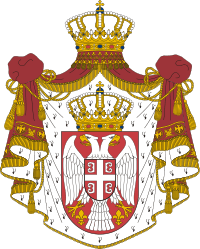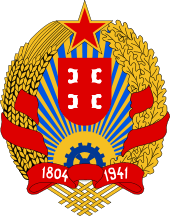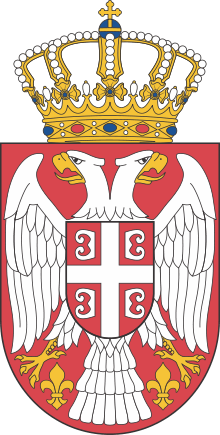Coat of arms of Serbia
| Coat of arms of Serbia | |
|---|---|
 | |
| Versions | |
|
Lesser coat of arms | |
|
Escutcheon | |
| Details | |
| Armiger | Republic of Serbia |
| Adopted | 17 August 2004 (16 June 1882) |
| Crest | The Crown of Serbia |
| Escutcheon | Gules, an eagle displayed with two heads Argent armed Or, between two fleurs-de-lys in base Or, surmounted by an inescutcheon Gules thereon a cross between four firesteels Argent |
| Other elements | Behind the shield a mantle Gules fringed and tasselled Or and lined ermine, at the top thereof the Crown of Serbia proper |
| Earlier versions | See history and gallery |
| Use | Governmental |
The coat of arms of Serbia is a re-introduction of the coat of arms of the Kingdom of Serbia (1882–1918) adopted by the Republic of Serbia in 2004 and later slightly redesigned in 2010.[1] The coat of arms consists of two main heraldic symbols which represent the national identity of the Serbian people across the centuries, the Serbian eagle (a white double-headed eagle adopted from the Nemanjić dynasty) and the Serbian cross (or cross with fire-steels).[2]
History
1945-2004
The Emblem of the Socialist Republic of Serbia was adopted the same time as the flag, on 17 January 1947 as the State Coat of arms of the People's Republic of Serbia. It was designed by Đorđe Andrejević-Kun.
The traditional shield of arms of Serbia with 4 fire steels (but without the cross). The cross which has always been included shield of arms was removed for ideological reasons of socialist atheism. It was placed above a rising sun with a cog wheel symbolizing the workers and surrounded with a golden wreath of wheat and oak leaves, oak being a sacred Serbian tree. A red ribbon with dates 1804 and 1941 which refer to the dates of the first Serbian uprising against the Ottomans and the national uprising against the axis powers in the Second World War.
The socialist coat of arms remained in official use long after the dissolution of socialist Yugoslavia and after the red star was removed in 1992 from the flag. The National Assembly recommended usage of the old symbols of the Kingdom of Serbia on August 17, 2004. The recommended usage was made Law on May 11, 2009 thus officially replacing the socialist heraldic Coat of arms.[3]
Description
The principal field stands for the Serbian state. It consists of a white double-headed eagle on a red shield; its body and wings in white, and tongues, beaks, legs and claws in gold, between two golden fleur-de-lis. The inescutcheon stands for the Serbian nation; in a red shield, a cross between "B" (Cyrillic "Ve" or Greek "Beta"), is arranged in the quarters around it. All of the letters face horizontally outwards.
A blazon in heraldic terms is: Gules, a bicephalic eagle Argent armed Or, two fleurs-de-lys Or. Overall an escutcheon Gules, a cross Argent between four firesteels Argent. All crowned with a royal crown. The design on the inescutcheon has been used by Serbian states and the Serbian church since the Middle Ages. The four shapes around the central cross are a stylized form of letters, as explained above.
Although Serbia is now a republic, the coat of arms features the royal crown of the former monarchy. The lesser arms is used more frequently, appearing on passports, identity cards, driver's licenses, and the state flag.
Serbian eagle

The use of the double-headed eagle dates back to the late Byzantine era (since the 11th century). The double-headed eagle can be seen more often on inscriptions, medieval frescoes and embroidery on the clothes of Byzantine and Serbian royalty.[4][5] Grand Prince Stefan Nemanja (r. 1166-1196) was among the first in Serbia who used the symbol. The Serbian Orthodox Church also adopted it; the entrance of the Žiča monastery, which was the seat of the Archbishop of the Serbs between 1219–1253, and by tradition the coronational church of the Serbian kings, is engraved with the double-headed eagle. The survived golden ring of Queen Teodora (1321–1322) has the symbol engraved. The Nemanjić dynasty coat of arms was the double-headed eagle. During the reign of Emperor Stefan Dušan (r. 1331–1345), the double-headed eagle can be seen on everyday objects and state related documents, such as vax stamps and proclamations. In 1339, map maker, Angelino Dulcert, marks the Serbian Empire with a flag with a red double-headed eagle.[6] Other Serbian dynasties also adopted the symbol as a symbolic continuation, like the Mrnjavčević and Lazarević. Prince Lazar (r. 1371-1389), when renovating the Hilandar monastery of Mount Athos, engraved the double-headed eagle at the northern wall.[7] The Codex Monacensis Slavicus 4 (fl. 1371-1389) has richly attested artwork of the Serbian eagle. The double-headed eagle was officially adopted by Stefan Lazarević after he received the despot title, the second highest Byzantine title, by John VII Palaiologos in August 1402 at the court in Constantinople.[8]
Serbian cross

Τhe so-called Serbian Cross, surrounded by four Ve also derives from a Byzantine emblem. It is almost the same or identical with the imperial emblem used in Byzantine flags during the late age. As a Byzantine symbol though, it might dates back to several centuries earlier. Serbian historian Stanoje Stanojević argues that it was officially adopted as a Serbian symbol as well in 1345, with Dušan the Mighty's raising to a Serbian Empire.[9] Stojan Novaković argues that the recorded use of the Serbian cross, as a national symbol, began in 1397, during the rule of Stefan Lazarević.[9] It was possibly derived from a known candle chandelier from the Visoki Dečani.[9] Later, the Serbian cross is found in the Korenić-Neorić Armorial (1595), which shows the coat of arms of Serbia (Svrbiae) as a white cross over a red and gold background, also depicting the Mrnjavčević noble house with the same design, with inverted colours and the Serbian eagle in the center of the cross. According to Mavro Orbini (1607), it was used by Vukašin Mrnjavčević (King, 1365–1371) and Lazar Hrebeljanović (Prince, 1371–1389).[9] Miloš Obrenović adopted the Serbian cross as the military flag when forming the first units of the regular army in 1825.[10] The Serbian cross then appeared on all Serbian coats of arms, except the Serbian coat of arms dated 1947, which had the cross removed, leaving only the four stylized firesteels; this was done symbolically by the Yugoslav government to "socially curtail and politically marginalize religious communities and religion in general".[11]
In modern times, a Serbian folk etymology interpreted the four letters around the cross as a stylised form of Cyrillic "C", a belief which is sometimes reflected on older coats of arms. In all of these coat of arms though (see gallery below), the letters retain the straight side of the letter B, or at least a projection in the middle, that is the middle part of "B" between the two semicircles.
Gallery
_(14th_century).svg.png) 14th-century coat of arms, Fojnica Armorial (between 1675-1688)
14th-century coat of arms, Fojnica Armorial (between 1675-1688).svg.png) coat of arms of Kingdom of Serbia (1718-39)
coat of arms of Kingdom of Serbia (1718-39) Serbian Empire, Hristofor Žefarović's Stemmatographia (1741)
Serbian Empire, Hristofor Žefarović's Stemmatographia (1741).jpg) Serbian coat of arms, Stemmatographia (1741)
Serbian coat of arms, Stemmatographia (1741)- Government seal
(First Serbian Uprising, 1805–1813) - Karađorđe's seal
(1804–1813)  Principality of Serbia
Principality of Serbia
(1835–1882).svg.png) Kingdom of Serbia (1882–1918)
Kingdom of Serbia (1882–1918) Kingdom of Yugoslavia (1918–1944)
Kingdom of Yugoslavia (1918–1944) Government of National Salvation (1941-1944)
Government of National Salvation (1941-1944) Socialist Republic of Serbia (1947–1990) and Republic of Serbia (1990–2004)
Socialist Republic of Serbia (1947–1990) and Republic of Serbia (1990–2004) Coat of arms of the Federal Republic of Yugoslavia (1992-2003) and the State Union of Serbia and Montenegro (2003–2006)
Coat of arms of the Federal Republic of Yugoslavia (1992-2003) and the State Union of Serbia and Montenegro (2003–2006)
See also
- List of coats of arms of Serbia
- Serbian cross
- Serbian eagle
- Serbian heraldry
- National symbols of Serbia
- Coat of arms of Yugoslavia
References
- ↑ "Grb Srbije: Dvoglavi orao menja perje" [Coat of arms of Serbia: Double-headed eagle changes feathers] (in Serbian). Večernje novosti. 20 November 2010. Retrieved 13 June 2013.
- ↑ Atlagić 2009, p. 180.
- ↑ "Zakon o izgledu i upotrebi grba, zastave i himne Republike Srbije — English: Law on the Appearance and Use of the Coat of arms, the Flag and the Anthem of the Republic of Serbia". Official Gazette of the Republic of Serbia – No. 36/2009 (in Serbian). Narodna skupština Republike Srbije – JP "Službeni glasnik". 11 May 2009. Retrieved 7 October 2012.
- ↑ Solovjev 1958, p. 130.
- ↑ J. Kovacevic (1953). Medieval Clothes of the Slavs in the Balkans. pp. 19–97, 183–210.
- ↑ Solovjev 1958, pp. 134–135.
- ↑ Ivić 1910, p. 30.
- ↑ Jahrbücher für Geschichte Osteuropas, vol. 8, Osteuropa-Institut München, F. Steiner Verlag, 1960, p. 511
- 1 2 3 4 Atlagić 1997, pp. 4–5.
- ↑ Posebna izdanja 295. Srpska Akademija Nauka i Umetnosti. 1957. p. 133.
- ↑ Mitja Velikonja. Religious Separation and Political Intolerance in Bosnia-Herzegovina. p. 187.
nations (in a symbolical sense as well, for example, by removing the cross from the Serbian coat of arms but keeping the four stylized esses), and to socially curtail and politically marginalize religious communities and religion in general.
Sources
- Atlagić, Marko (1997). "The cross with symbols S as heraldic symbols" (PDF). Baština. 8: 149–158. Archived from the original (PDF) on May 21, 2013.
- Atlagić, Marko (2009). "Određivanje nacionalnih heraldičkih simbola na primjeru Srba i Hrvata" [Étude des symboles nationaux héraldiques à l' exemple des Serbes et des Croates] (PDF). Zbornik radova Filozofskog fakulteta u Prištini. 39: 179–188.
- Milićević, Milić (1995). Grb Srbije: razvoj kroz istoriju. Službeni glasnik.
- Ivić, Aleksa (1910). Stari srpski pečati i grbovi: prilog srpskoj sfragistici i heraldici. Natošević.
- Ivić, Aleksa; Mrđenović, Dušan; Spasić, Dušan; Palavestra, Aleksandar (1987). Rodoslovne tablice i grbovi srpskih dinastija i vlastele. Belgrade: Nova knjiga.
- Novaković, Stojan (1884). "Хералдички обичаји у Срба: у примени и књижевности". Београд: Краљевско-српска државна штампарија.
- Palavestra, Aleksandar (2010). Илирски грбовници и други хералдички радови. Belgrade: Dosije studio.
- Palavestra, Aleksandar (June 1998). "O ocilima" (PDF). Glasnik SHD (in Serbian). Archived from the original (PDF) on 2013-10-29.
- Solovjev, Aleksandar Vasiljevič (1958). Istorija srpskog grba. Srpska misao.
- Stanojević, Stanoje (1934). "O srpskom grbu". Iz naše prošlosti. Belgrade: Geca Kon A. D. pp. 85–90.
External links
| Wikimedia Commons has media related to Coats of arms of Serbia. |
- "Serbian Heraldic Society".
- Ljubodrag Grujic. "О грбу Србије и мом раду на њему".



